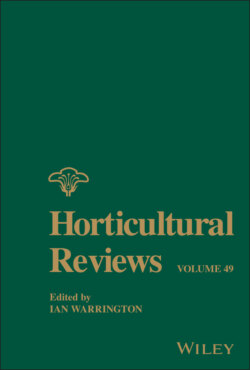Читать книгу Horticultural Reviews, Volume 49 - Группа авторов - Страница 16
III. NATURAL DISTRIBUTIONS OF HYDRANGEA SPECIES
ОглавлениеHydrangea are distributed across both tropical and temperate regions of the world, primarily localizing in Asia and the Pacific islands near the Asian mainland (considered to be the center of origin; Cerbah et al. 2001) as well as North and South America. In North America at least three species are known to exist, H. arborescens, H. barbara, and H. quercifolia according to the most recent revision (De Smet et al. 2015). This treatment of the genus places Decumaria barbara L. (climbing hydrangea) into Hydrangea section Decumaria as H. barbara. Hydrangea arborescens includes three subspecies which have been argued to be separate species (Pilatowski 1982), based on a study of trichome morphology and crossing experiments which indicated a cross‐incompatibility between H. arborescens spp. radiata, spp. cinerera, and spp. arborescens. However, the crossing experiments also suggested that all three taxa are self‐compatible, which is contrary to more recent studies (Reed 2000, 2004). Additionally, De Smet et al. (2015) found H. arborescens to form one genetically distinct (albeit morphologically diverse) species. H. arborescens occurs from New York in the north to the Florida panhandle in the south, and west to Arkansas (McClintock 1957). The western extent of the H. barbara range is in Louisiana, extending north to Tennessee and northeast along the Atlantic coast to New York and into the peninsula of Florida in the southeast (USDA, NCRS 2020). H. quercifolia overlaps slightly with the range of H. arborescens and more substantially with H. barbara. Two, and rarely all three, of these species are found to co‐occur within the region where the native ranges overlap (A. Sherwood, pers. observ.).
Hydrangea section Cornidia is located almost exclusively in Mexico, Central America, and along the western coast of South America (McClintock 1957). The only exception within this section is H. integrifolia Sieb. which is found in Taiwan and the Philippines. This section contains at least 12 known species, including the relatively recently discovered H. albostellata (Samain et al. 2014) in Mexico. Species in this section are root‐climbing lianas that occur in the primary rainforest and are unique by being functionally dioecious and having evergreen leaves. Interestingly, many of the species which occur in the tropical regions of South America are confined to the high altitudes of the Andes Mountains where the climate is more temperate (McClintock 1957). Several of these species are at risk of extinction due to habitat loss (Samain et al. 2014) and further exploration is required to determine if more previously undescribed taxa exist.
In Asia, Hydrangea are distributed from the Himalayan Mountains in the west to Japan in the east and south to the Indonesian islands. Some of the Asian taxa are confined to the islands on the eastern edge of the continent (i.e., H. sikokiana Maxim., H. hirta Sieb., and H. involucrata Sieb. are mostly found in Japan). However, most of the Asian hydrangeas are also distributed across the continental mainland (McClintock 1957).
Several Hydrangea fossils have been discovered, including in Alaska (Hollick 1925), Idaho (Niklas and Brown 1981), and Oregon (Manchester 1994). Although the evidence is limited to sepal fossils for the Idaho and Alaska specimens, a more complete inflorescence represents the specimen from Oregon. Based on the available evidence it seems as though the specimens may represent extinct species and suggests that the prehistoric range of hydrangea in North America was much larger.
